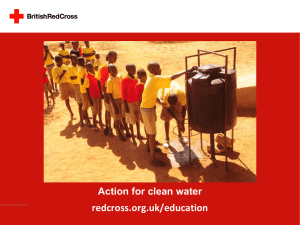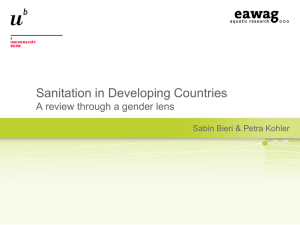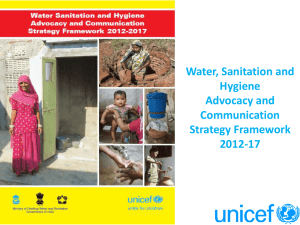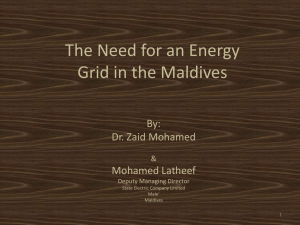Policy 1 - ministry of water supply and drainage
advertisement
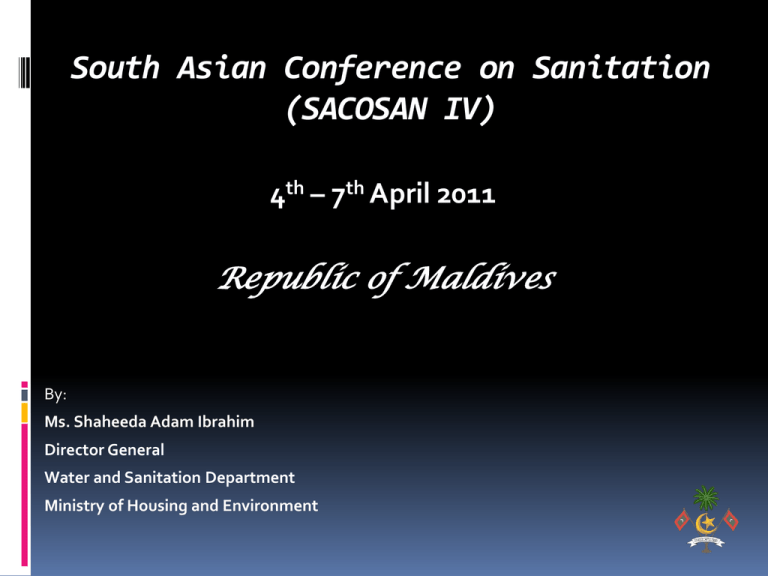
South Asian Conference on Sanitation (SACOSAN IV) 4th – 7th April 2011 Republic of Maldives By: Ms. Shaheeda Adam Ibrahim Director General Water and Sanitation Department Ministry of Housing and Environment Country Profile Total no. of islands : 1190 No. of inhabited islands : 198 Geographical area :90,000km2 Land area : 300km2 No. of geographic atolls is 26 and administrative is 20 Elevation: Less than 2m above mean sea level Population of Maldives. : 324,992 Population of the capital, Male’: 103,693 ( Area : 2sq. Km ) Annual growth rate : 1.69% Climate :Tropical, warm and humid Mean Annual Temperature : 25 to 31 Degrees Celsius Annual rainfall : 2000mm Water and Sewerage Services Background: • In Maldives water resources are mainly available as groundwater and rain water Maldives has very little in terms of freshwater resources. There is practically no surface water sources Freshwater resources exists as groundwater - unconfined and extends below seal level in the form of a thin freshwater lens. These island aquifers lie at a depth of 1-1.5 meters below the surface Rainwater harvesting is the primary source of drinking water in 90% of the outer islands with groundwater used for washing, agriculture and other domestic uses. Desalinated water is mainly used in the capital island with piped connections. Wastewater disposal systems in most of the outer islands are within the plot (on-site sanitation using septic tanks and soak pits). In the capital and 22 other islands sewerage systems are installed Country Commitment The provision of safe drinking water supply and sanitation is regarded as a basic right for all Maldivians in the new constitution of the country (2008) To achieve the goals and objectives of the sector the priority areas and activities are included in the national development plans and programmes: The National Strategic Action plan 2009-2013 -the principal planning document of the Government includes Policies, Goals, Objectives and strategies for the water and sanitation sector The Ministry of Housing and Environment Annual work plan with activities and budget National Adaptation Plan of Action (NAPA) Goals and objectives of the sector 1. Ensure access to safe drinking water and sanitation facilities as a basic human right for all. 2. Protect and preserve the country’s vital fresh water resources and establish water stocks for use in emergency and disasters. 3. Enhance the role of private sector participation in the provision of water and sanitation services while encouraging a smooth shift in the role of the government as a regulator and facilitator in the provision of these services. 4. Introduce the use of renewable energy and other modern technologies to minimize the cost of providing drinking water and sanitation systems and to protect ground water. Key Sector Policies: Strategic Action Plan (2009-2013) : Policy 1: Improve accessibility in delivery of safe water and sanitation services. Policy 2: Prioritize provision of safe water and sanitation when designing development projects and emergency response. Policy 3: Establish effective operation and maintenance procedure for water and sanitation systems in the Maldives. Policy 4: Facilitate private sector investment in the water and sanitation sector. Policy 5: Strengthen technical, financial and human resources capacity for water and sanitation sector. Policy 6: Enhance community and civil society participation in the water and sanitation sector. Policy 7: Strengthen legal and institutional framework to improve sector performance. Policy 8: Improve water resources management to preserve environment. Policy 9: Improve safe water consumption at public and domestic levels through implementation of thorough water safety plans. Sanitation Coverage ,2006 census. access to improved sanitation with island wide sewerage systems in Maldives Male’ ( Urban) Outer Islands Republic 15% 37% 100 % • 85% 63% % access to sewer network % without access to sewer network On-site sanitation is not considered as safe sanitation. Types of Sewerage Systems Sewerage systems are in operation in 22 islands: •Small bore systems (9 islands) •Conventional gravity system (11 islands) •Vacuum systems (4 islands) Types of Sewerage Treatment systems in operation • Aeration system •Filter Beds •Rotating Bio Dics Vilifushi Island Area : 13.5 ha Density (land/capita) : 691 sq.ft Type of system - Conventional gravity HDPE: 160 & 225 STP : RBC - Aeration Vilifushi-Sewerage Treatment Plant RBC - Aeration Filtration – Chlorination Sea Outfall & Recharge Vilifushi-Drying bed & Compost used for agriculture/gardening Environment Friendly methods Access to safe sanitation facilities in outer islands 9 8 7 6 5 4 3 2 1 0 2007 2008 2009 2010 Challenges Lack of institutional and financial capacity for establishment, operation and management of water and sewerage services Providing services to all the islands - dispersed population ( Individual systems for different islands) Lack of cost effective technology for small islands. Lack of trained personnel in the sector Lack of regulatory framework, guidelines and standards Lack of capacity to respond in an emergency and in mitigating the impacts of climate change (water shortages during dry periods) THANK YOU





